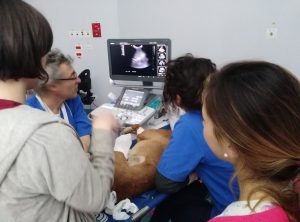Hemostatic findings of pleural fluid in dogs and the association between pleural effusions and primary hyperfibrino(geno)lysis: A cohort study of 99 dogs
Zoia A, Drigo M, Piek CJ, Simioni P, Caldin M.
Hemostatic findings of pleural fluid in dogs and the association between pleural effusions and primary hyperfibrino(geno)lysis: A cohort study of 99 dogs.
PLoS One. 2018 Feb 20;13(2):e0192371. doi: 10.1371/journal.pone.0192371. eCollection 2018.
Scarica pubblicazione
The primary objective of this study was to determine if activation of coagulation and fibrinolysis occurs in canine pleural effusions. Thirty-three dogs with pleural effusions of different origin were studied. Pleural effusion fibrinogen concentrations were significantly lower, while pleural fibrin-fibrinogen degradation products (FDPs) and D-dimer concentrations were significantly higher than those in plasma (P < 0.001 for all comparisons). These results show that, in canine pleural fluids, there is evidence of coagulation activation and fibrinolysis. The secondary aims of the current study were to determine if primary hyperfibrinolysis ([PHF] i.e., elevated plasma FDPs with a normal D-dimer concentrations), occurs in dogs with pleural effusion, and whether the presence of a concurrent inflammatory process may have activated the hemostatic cascade, with its intrinsically linked secondary hyperfibrinolysis, masking the concurrent PHF. The previously 33 selected dogs with pleural effusion (group 1) were compared to two control groups of 33 healthy (group 2) and 33 sick dogs without pleural effusion (group 3). Serum fibrinogen, FDPs, D-dimer, C-reactive protein (CRP), fibrinogen/CRP ratio, and frequency of PHF were determined. Fibrinogen, FDPs, D-dimer and CRP concentrations in group 1 were significantly increased compared to group 2 (P < 0.001 for all comparisons). FDPs and CRP concentrations in group 1 were also significantly increased compared to group 3 (P = 0.001 and P < 0.001, respectively). The fibrinogen/CRP ratio was significantly decreased in group 1 compared to groups 2 and 3 (P < 0.001 for both comparison). The frequency of PHF was significantly higher in group 1 compared to groups 2 (P = 0.004), but not compared to group 3. These results support the hypothesis that PHF occurs significantly more often in dogs with pleural effusion compared to healthy dogs. Nevertheless, the decrease in the fibrinogen/CRP ratio in group 1 compared to group 3, considering the higher FDPs and similar D-dimer concentrations, would suggest that PHF is also more frequent in dogs with pleural effusion compared to sick control dogs, and that this phenomenon is hidden due to concurrent secondary hyperfibrinolysis.






 Il Direttore Sanitario Dott. Marco Caldin
Il Direttore Sanitario Dott. Marco Caldin